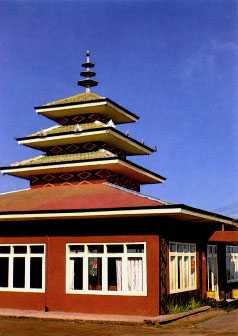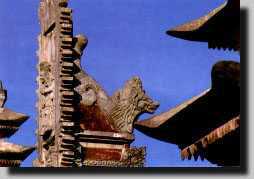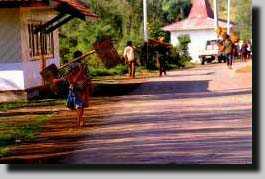|

Wonokitri
  The village of Wonokitri
is an important centre of Tenggerese culture. Claiming descent
from the kingdom of Majapahit, the people retain a Hindu/Javanese
faith, not unlike that found on the neighbouring island of Bali.
At Wonokitri, it is possible to visit the pura (temple), witness
occasional cremation ceremonies and generally experience traditional
Tenggerese culture. The people are horse breeders and hillside
farmers, cultivating a wide variety of excellent fruit and vegetables
on almost impossibly steep slopes. The cool climate and rich,
volcanic soil allows the cultivation of many plants which are
impossible to grow on the plains. The Tenggerese have their own
explanation for the abundance of their crops, related to their
legendary past. In this version of the story, the child Kesuma
was sacrificed as payment for the bountiful harvests granted
by the gods on Mt Semeru. The village of Wonokitri
is an important centre of Tenggerese culture. Claiming descent
from the kingdom of Majapahit, the people retain a Hindu/Javanese
faith, not unlike that found on the neighbouring island of Bali.
At Wonokitri, it is possible to visit the pura (temple), witness
occasional cremation ceremonies and generally experience traditional
Tenggerese culture. The people are horse breeders and hillside
farmers, cultivating a wide variety of excellent fruit and vegetables
on almost impossibly steep slopes. The cool climate and rich,
volcanic soil allows the cultivation of many plants which are
impossible to grow on the plains. The Tenggerese have their own
explanation for the abundance of their crops, related to their
legendary past. In this version of the story, the child Kesuma
was sacrificed as payment for the bountiful harvests granted
by the gods on Mt Semeru.
The usual departure point for the crater of Bromo is from Ngadisari.
The walk takes more than two hours, almost half of which is spent
crossing the sand sea.
Vehicles can drive up to Cemara Lawang after obtaining special
permits, from where the rest of the journey on foot takes not
much more than 45 minutes. Another possibility, and a  popular alternative, is to approach
the crater on horseback, either from Ngadisari or from the hotel
at Cemara Lawang. Horses and guides are plentiful and can be
arranged on the evening before setting out. The guides at Cemara
Lawang begin to congregate at about 4.a.m., after which they
all descend together in a mysterious procession. Low lying fog
which often envelops the flat, sandy plain adds to a sense of
mystery. The temperature drops several degrees during the descent
and the combination of chill air and echoing horse's hoofs in
the darkness gives one the feeling of walking across a huge frozen
lake. The guides try to arrange it so that visitors reach the
foot of the crater at first light. From here a long flight of
steps leads up to the crater rim. As the sun rises, the early
morning mist dissipates to reveal a fantastic, almost lunar landscape.
Two deeply furrowed volcanic cones stand side by side on a vast,
perfectly flat expanse of sand 10 km across. Bromo's crater is
active, emitting dense clouds of sulphureous steam. Reasonably
quiescent at the moment, the mountain has erupted three times
this century at fairly regular 30 year intervals. The last major
eruption was during the early seventies. Beside Bromo stands
its dormant twin, Mt Batok, whose deeply furrowed sides rise
in a perfect cone shape to a flat summit. The entire circular
plain is surrounded by steep cliffs, which form the rim of an
enormous caldera. popular alternative, is to approach
the crater on horseback, either from Ngadisari or from the hotel
at Cemara Lawang. Horses and guides are plentiful and can be
arranged on the evening before setting out. The guides at Cemara
Lawang begin to congregate at about 4.a.m., after which they
all descend together in a mysterious procession. Low lying fog
which often envelops the flat, sandy plain adds to a sense of
mystery. The temperature drops several degrees during the descent
and the combination of chill air and echoing horse's hoofs in
the darkness gives one the feeling of walking across a huge frozen
lake. The guides try to arrange it so that visitors reach the
foot of the crater at first light. From here a long flight of
steps leads up to the crater rim. As the sun rises, the early
morning mist dissipates to reveal a fantastic, almost lunar landscape.
Two deeply furrowed volcanic cones stand side by side on a vast,
perfectly flat expanse of sand 10 km across. Bromo's crater is
active, emitting dense clouds of sulphureous steam. Reasonably
quiescent at the moment, the mountain has erupted three times
this century at fairly regular 30 year intervals. The last major
eruption was during the early seventies. Beside Bromo stands
its dormant twin, Mt Batok, whose deeply furrowed sides rise
in a perfect cone shape to a flat summit. The entire circular
plain is surrounded by steep cliffs, which form the rim of an
enormous caldera.
|

